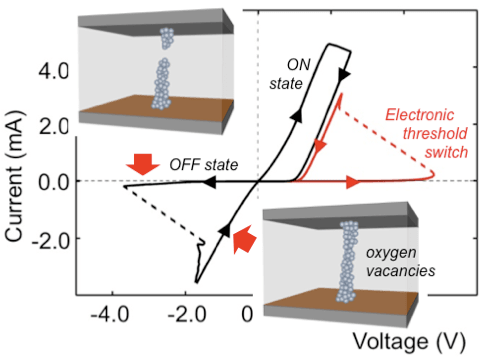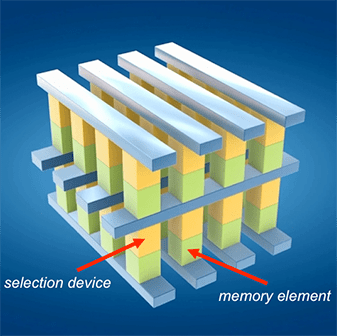
Neuromorphic computing
One way to increase the speed and energy efficiency of computing is to (i) perform computation in a massively parallel way rather than sequentially one operation at the time and (ii) execute operations in memory rather than moving data to the processor. Neuromorphic (brain-like) computing is using both of the above. Unfortunately, however, it is difficult to implement this approach using standard CMOC circuits. One needs to develop specialized devices that could perform functions of neurons and synapses, the building blocks of a human brain. Such devices operate on different principles and use different materials that current electronic circuits.
Non-volatile memories
These devices are based on binary oxides such as Ta2O5 and HfO2 or Ge-Sb-Te amorphous alloys. They store information by having their resistance change due to drift of oxygen and metal ions in the electric field and temperature gradient (in oxides). The metal-rich material forms a narrow conducting filament between the metal electrodes. The low resistance state (logical "1") corresponds to continuous filament while the high resistance is caused by the break in the filament (logical "0") (figure below).
Ge2Sb2Te5-based devices encode information in the form of crystalline or amorphous state of the functional layer. Currently addressed problems are endurance and resistance drift. Most of device processing including thin film deposition, lithography, etching, ion milling, and passivation is done in our new NanoFab facility.
Selection devices
Memory arrays are usually arranged in the form of crossbar arrays with memory elements located at the intersections of "bit" lines and "word" lines. A particular bit is accessed by application of a voltage to one bit and one word line. In addition to one cell that is selected, there are many that are half selected (along biased word and bit lines). The READ errors can be prevented by adding a selection device in series with each memory element (figure on right). We investigate threshold switching devices based on oxides and chalcogenides for these applications.
3D XPoint memory announced by Intel in July 2015 and sold under the bard name Optane includes resistive switching devices and threshold switches.
Collaborations:

![]()
![]()

![]()